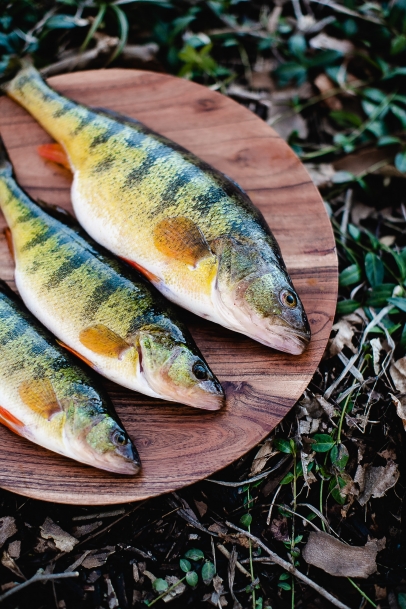Panfish
To be fully transparent, my knowledge of cooking panfish was minimal before creating these recipes. Luckily, I have a few close friends who are avid anglers. Freshly caught fish are not an uncommon sight at our potlucks, where pictures of the catch, just hours before on a small boat, are passed around. With the help of my friends, I now have a greater understanding of panfish and have fallen in love with the entire “water to table” process.
If you are new to eating panfish and want to keep things simple, there is nothing wrong with lightly frying your catch in a pan with butter and salt. I recommend it, and it’s how panfish got their name! It’s a wonderful way to understand the flavors of a fish you have never eaten before. No matter how you get your hands on panfish—whether you catch the fish yourself, find it at a market or get some from a friend— don’t let fear get in the way of trying something new.
Selecting:
The term “panfish” is used by anglers to refer to a catch that typically doesn’t grow larger than the size of a frying pan. The panfish label encompasses many species of freshwater and saltwater fish and there is no written rule about which fish make the list. However, I think most local anglers would agree on including the following freshwater catches: bluegill, crappie, perch, redear sunfish and pumpkinseed sunfish.
Panfish can be found in lakes, streams and ponds. They spawn and repopulate easily, making them abundant in our area. However, pay attention to local fishing regulations because there is a daily bag limit for certain species. Make sure to secure the proper fishing license for the area you plan to fish in.
Each species will have an ideal size for consumption. You should throw back extra-large catches, as these larger fish preserve the genetics of the species and ensure larger panfish for future fishing. Some species have a minimum size requirement as well, so check local regulations. Panfish can sometimes be found in the frozen seafood aisle of local grocery stores and supermarkets. Be sure to consume before the listed expiration date.
Storing:
Once you have caught your panfish, use a clean knife to properly bleed the fish; this is more humane for the catch and ensures the best possible flavor. Put the fish in a plastic bag and place it in a cooler full of ice until you are ready to fillet. Clean and fillet each fish, rinse the fillets under cold water and pat them dry with a paper towel. Wrap the fillets with a layer of wax paper or parchment paper and then tightly wrap again with a layer of aluminum foil and place in the refrigerator. Consume within 2 to 3 days. To freeze the fillets, place them in a freezer bag and remove as much air from the bag as possible or use a vacuum sealer. The fillets will last in the freezer for up to 12 months.
Pairing:
Alliums, arugula, asparagus, avocados, basil, bay leaves, beans, beer, beets, blackberries, blueberries, broccoli, butter, cabbage, capers, carrots, cauliflower, celery, cheese, cilantro, coconut, coriander, corn, cranberries, cucumbers, curry, dill, eggs, fennel, garam masala, ginger, honey, kale, lemons, lentils, limes, liquor, mango, mayonnaise, milk, mint, mushrooms, mustard, nuts, olives, oranges, oregano, parsley, peas, peppers, pork, potatoes, radishes, rosemary, rice, sage, sesame, soy, spinach, squash, strawberries, sweet potatoes, Swiss chard, tarragon, thyme, tomatoes, vinegar, wine, Worcestershire sauce
Thank you to local anglers Scott Lehman and Tom Starkweather, who contributed their knowledge and freshly caught panfish for this piece.
Ashley Swartzendruber is Edible Michiana’s recipe editor, stylist and photographer based in Goshen, Indiana. She can be found cooking, eating and photographing local food in her home or exploring Michiana with her family. You can find more of her photos, styling and motherhood musings on her Instagram @mywildhaven.





